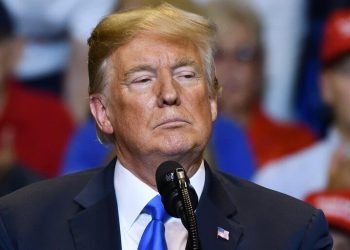My first question, when the White House unveiled its tariff regime, was, “How on earth did they calculate such huge rates?” Reciprocal tariffs, after all, are supposed to treat other countries the way they treat us, and foreign tariffs on American goods are nowhere near these levels.
The next day it got personal. The Office of the U.S. Trade Representative released its methodology and cited an academic paper produced by four economists, including me, seemingly in support of their numbers. But they got it wrong. Very wrong. I disagree fundamentally with the government’s trade policy and approach. But even taking it at face value, our findings suggest the calculated tariffs should be dramatically smaller — perhaps one-fourth as large.
Let’s start with the biggest mistake. The office said it calculated its reciprocal tariffs at a level that would theoretically eliminate trade deficits with “each of our trading partners,” one by one. Is that a reasonable goal?
It is not. Trade imbalances between two countries can emerge for many reasons that have nothing to do with protectionism. Americans spend more on clothing made in Sri Lanka than Sri Lankans spend on American pharmaceuticals and gas turbines. So what? That pattern reflects differences in natural resources, comparative advantage and development levels. The deficit numbers don’t suggest, let alone prove, unfair competition.
There are some reasonable arguments in favor of reducing the overall trade deficit, such as to reduce risks from our debt. But these arguments don’t apply country by country. The Nobel laureate Robert Solow explained why when he quipped, “I have a chronic deficit with my barber, who doesn’t buy a darned thing from me.” Mr. Solow also surely ran a chronic surplus with his students, and these imbalances reveal nothing about trade barriers in hair care or higher education, nor would they speak to his financial health.
For the sake of argument, let’s grant President Trump his goal of eliminating all trade deficits, no matter how destructive that would be. Could these reciprocal tariffs succeed?
Again, no. The administration’s tariff formula assumes that a tariff placed on one country won’t affect imports from any others and ignores any implications for exports. These assumptions may work for an action against one small trade partner, but not for the broad salvo announced last week. A large tariff on Japanese auto parts could cause an increase in demand for imports from Mexico and vice versa. And the tariffs clearly invite retaliation and may over time increase the dollar’s value, both factors that would most likely depress U.S. exports.
Let’s keep going. Not only will we grant the government its goal, but we will also ignore flaws in its tariff formula. Do the computed tariffs then look right?
Guess what? They do not. The government’s formula uses four different numbers to calculate tariffs, including imports and exports for each trading partner. The part that directly relates to our research is an estimate of how much import prices change in response to the additional costs imposed by tariffs.
The value of that term, known as the rate of pass-through, isn’t obvious and depends on how companies behave. If foreign exporters cut prices to fully offset the tariffs, leaving import prices unchanged, the pass-through would be zero. Alternatively, it could equal 100 percent if exporters don’t budge, which means import prices would rise in step with the tariffs.
Alberto Cavallo, Gita Gopinath, Jenny Tang and I studied the tariffs placed on Chinese exports in 2018 and 2019. (This is the “Cavallo et al.” reference in the government’s methodology.) We found that tariffs of, say, 20 percent caused domestic importers to pay nearly 19 percent more. This represents a pass-through into import prices of about 95 percent, which is the value I would have plugged into the government’s tariff formula. In simple terms, that implies that the price paid for U.S. imports would rise almost as much as the tariff rate.
The administration’s trade office cites our work, but mentions a different result from the paper, which found a low pass-through rate to the listed prices at two retailers. The Trump administration then plugs a rate of 25 percent into its formula. Where does 25 percent come from? Is it related to our work? I don’t know. The reciprocal tariffs have enormous implications for workers, firms, consumers and stock markets around the globe. But the methodology note offers shockingly few details.
Had the trade office instead used a value closer to the 95 percent number from our work, as I believe it should have done, the computed tariffs would have been as little as one-fourth of what they are.
As a result of these and other methodological choices, Wednesday’s reciprocal tariffs will bring average tariff rates to their highest level in over 100 years. Their breadth is striking, hitting large economies such as China and Europe, and also small developing and emerging-market countries including Jordan and Zambia. And despite being billed as a “do unto others” trade policy, they are not calculated in line with the Bible’s golden rule.
I would strongly prefer that the policy and methodology be scrapped entirely. But barring that, the administration should divide its results by four.
Brent Neiman is an economics professor at the University of Chicago’s Booth School of Business. From 2022 to earlier this year he served at the U.S. Treasury as a counselor to the secretary and the deputy under secretary for international finance.
The Times is committed to publishing a diversity of letters to the editor. We’d like to hear what you think about this or any of our articles. Here are some tips. And here’s our email: letters@nytimes.com.
Follow the New York Times Opinion section on Facebook, Instagram, TikTok, Bluesky, WhatsApp and Threads.
#Opinion #Trumps #Tariff #Math #Joke





















